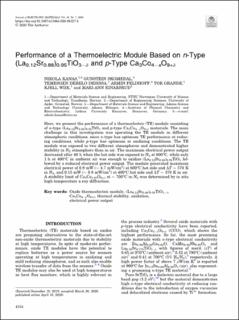| dc.contributor.author | Kanas, Nikola | |
| dc.contributor.author | Skomedal, Gunstein | |
| dc.contributor.author | Desissa, Temesgen D. | |
| dc.contributor.author | Feldhoff, Armin | |
| dc.contributor.author | Grande, Tor | |
| dc.contributor.author | Wiik, Kjell | |
| dc.contributor.author | Einarsrud, Mari-Ann | |
| dc.date.accessioned | 2020-10-08T09:06:02Z | |
| dc.date.available | 2020-10-08T09:06:02Z | |
| dc.date.created | 2020-09-22T15:10:26Z | |
| dc.date.issued | 2020 | |
| dc.identifier.citation | Kanas, N., Skomedal, G., Desissa, T. D., Feldhoff, A., Grande, T., Wiik, K. & Einarsrud, M.-A. (2020). Performance of a thermoelectric module based on n-type (La0.12Sr0.88)0.95TiO3-δ and p-type Ca3Co4-xO9+δ. Journal of Electronic Materials, 49(7), 4154-4159. doi: | en_US |
| dc.identifier.issn | 1543-186X | |
| dc.identifier.uri | https://hdl.handle.net/11250/2681693 | |
| dc.description.abstract | Here, we present the performance of a thermoelectric (TE) module consisting of n-type (La0.12Sr0.88)0.95TiO3 and p-type Ca3Co4-xO9+δ materials. The main challenge in this investigation was operation of TE module in different atmosphere conditions, since n-type has its optimum TE-performance at reducing, while p-type at oxidizing conditions. The TE module was exposed to two different atmospheres and demonstrated higher stability in N2 atmosphere than in air. The maximum electrical power output decreased after 40 h when the hot side was exposed to N2 at 600 °C, while only 1 h at 400 °C in ambient air was enough to oxidize (La0.12Sr0.88)0.95TiO3 followed by a reduced electrical power output. The module generated a maximum electrical power of 0.9 mW (~ 4.7 mW/cm2) at 600 °C hot side and ΔT ~ 570 K in N2, while 0.15 mW (~ 0.8 mW/cm2) at 400 °C hot side and ΔT ~ 370 K in air. A stability limit of Ca3Co3.93O9+δ at ~ 700 °C in N2 was determined by in situ high-temperature X-ray diffraction. | en_US |
| dc.language.iso | eng | en_US |
| dc.publisher | The Minerals, Metals, and Materials Society | en_US |
| dc.rights | Navngivelse 4.0 Internasjonal | * |
| dc.rights.uri | http://creativecommons.org/licenses/by/4.0/deed.no | * |
| dc.title | Performance of a thermoelectric module based on n-type (La0.12Sr0.88)0.95TiO3-δ and p-type Ca3Co4-xO9+δ | en_US |
| dc.type | Journal article | en_US |
| dc.type | Peer reviewed | en_US |
| dc.description.version | publishedVersion | en_US |
| dc.rights.holder | © 2020 The Author(s) | en_US |
| dc.subject.nsi | VDP::Teknologi: 500::Elektrotekniske fag: 540 | en_US |
| dc.source.pagenumber | 4154-4159 | en_US |
| dc.source.volume | 49 | en_US |
| dc.source.journal | Journal of Electronic Materials | en_US |
| dc.source.issue | 7 | en_US |
| dc.identifier.doi | 10.1007/s11664-020-08127-5 | |
| dc.identifier.cristin | 1832202 | |
| dc.relation.project | Research Council of Norway: 228854 | en_US |
| dc.relation.project | Deutsche Forschungsgemeinschaft (DFG, German Research Foundation): FE928/17-1 | en_US |
| dc.description.localcode | Paid Open Access | |
| dc.description.localcode | UNIT agreement | |
| cristin.qualitycode | 1 | |

